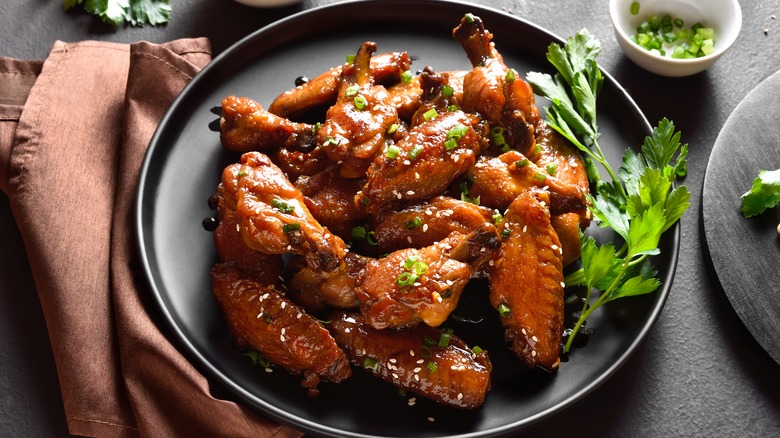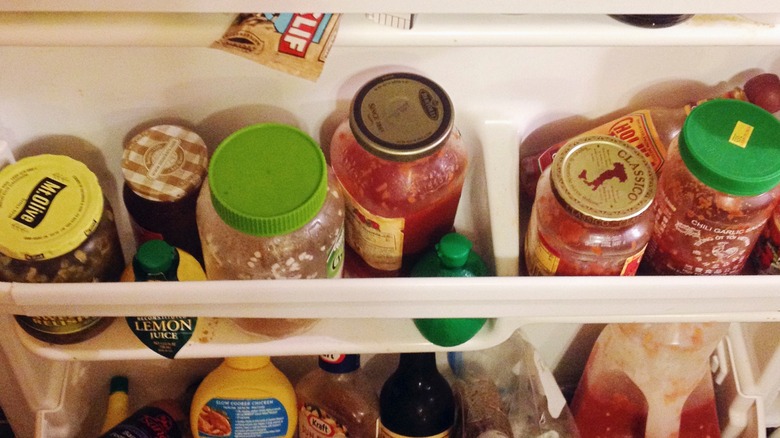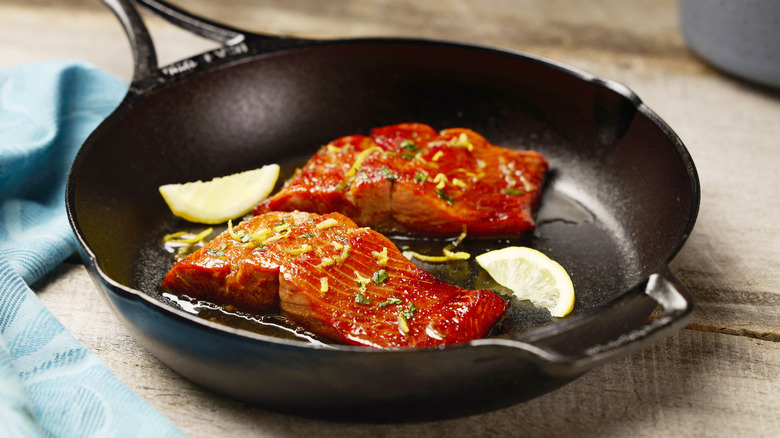The 2-Ingredient Meat Glaze That's Too Easy To Pass Up
It's fair to say that the refrigerator version of the "junk drawer" is the shelf on the side of your fridge door filled with condiments. Whether it's ketchup, soy sauce, or a big bottle of sriracha, your condiments also tend to stick around longer than they should. There's a tasty way to use these leftover bottles. You can get even more mileage from any mustard and jam by mixing them to make an easy meat glaze.
Meat glaze might be something you only think about when it's time for a ham, but a good glaze is a pretty versatile sauce for all kinds of dishes. Meat glaze is simply a thick, sticky sauce that brings concentrated, sweet, and sometimes spicy flavors to meats like chicken wings and fingers, broiled fish, and even tofu or seitan. And the great thing is, you don't have to buy another bottle of stuff to add to the collection in your fridge. Mix up any mustard and jam you already have hanging around.
Mixing jam and mustard is easy
On their own, jam and mustard are excellent condiments. Mustard can dress up a hot dog and clinch a vinaigrette recipe; plus, there are many different varieties from Dijon to whole grain, mild to spicy. Jam is indispensable for toast and English muffins, of course, plus it's perfect for spreading on top of a wheel of cheese before baking it in puff pastry. Bring the two together, and you can make all kinds of meats a little more magical.
You don't need a recipe to make a homemade meat glaze. Just experiment with different ratios of mustard to jam. Start with around two parts jam to one part mustard and see how you like the flavor. If it's too pungent, add a little more jam; if it's too sweet, add more mustard. You can use any kind of jam and mustard; there are no rules. If you think fig jam and spicy whole grain might taste good together, give it a go. The combination of sweet and sour that you get from mixing mustard and jam is a classic culinary combination, like American-style Chinese chicken dishes like General Tso's, slow-cooked sticky ribs, and even spread or tossed on seafood like shrimp and salmon.
Where to use your jam
Once you settle on a glaze, you can spread it on anything meaty (or meat-like). If the meat or protein is delicate, like shrimp, boneless and skinless chicken breast, or tofu, spread the glaze on the uncooked surface and cook it using medium heat so the glaze doesn't burn. If you're making something with crispy skin, like chicken thighs or drumsticks, cook the meat most of the way and then brush the glaze on in the last few minutes.
You can also use your glaze for two-step cooking. Try marinating salmon filets before cooking them in your glaze, and then brush the remaining glaze on top when the fish is almost ready, then flash them under the broiler until the glaze bubbles to make a caramelized candy-like coating.
Once you get the hang of mixing up homemade meat glaze, you'll probably find a lot of other ways to incorporate it in your cooking, like as a dipping sauce for french fries or chicken nuggets, or add it as an accompaniment to a charcuterie board. The best part is that you only need a few tablespoons of each to make enough glaze for a few pieces of meat, so it's the perfect way to use up a bottle or jar of mustard and jam before it's out of date. It'll also free up your fridge for new condiments.


